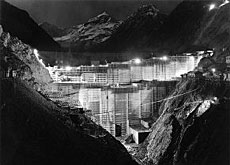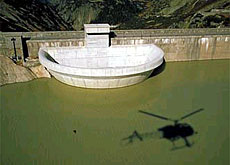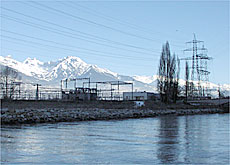Alpine giant powers Swiss households

The Grande Dixence hydroelectric complex ranks alongside Switzerland's alpine tunnels as one of country's engineering marvels.
Completed in 1965, its facilities in canton Valais provide 12 per cent of Switzerland’s stored hydroelectric power.
Construction of the Grande Dixence project – which includes four dams, three power plants and over 100 kilometres of tunnels – began in 1950 and was one of the major engineering feats of the post-war period.
The complex’s centrepiece is the Grande Dixence dam, the world’s tallest concrete gravity dam, which was built high in the mountains at more than 2,300 metres above sea level.
The project employed around 1,000 workers, mostly Swiss and Italians attracted by the good salaries on offer. But conditions were tough at the beginning.
“When we first went up in the mountains, we didn’t have proper housing,” recalls Albert Sierro, one of the project’s first workers. “They just put up bunks for us in old stables.”
Underground
The work was especially difficult for the miners who were digging the connecting tunnels to other valleys.
“Work went on seven days a week, 24 hours a day,” Sierro told swissinfo. “You had to work 11 hours every day, with just an hour’s break in the middle for meals.”
Conditions did improve, however, as the work progressed, with a small company town being built just below the construction site.
“We slowly got organised among ourselves, and we had all sorts of social activities,” says Sierro. “We even had a small clinic with a proper doctor and a post office.”
But according to Sierro, there was one vital element missing from the worksite: women.
“There were only two women working up there, and they were both nuns helping the doctor,” he remembers.
Harsh conditions
Because of the altitude, construction was slow. And during the winter months, cold temperatures meant that concrete for the dam could not be poured, further slowing work.
“The Italians usually went home then and we carried out maintenance work on the machinery,” says Sierro.
The project, because of its huge scale, also brought about social change in canton Valais. Until then, many people had left the canton to seek a better life elsewhere.
But the construction of the Grande Dixence complex generated income and jobs for local people who slowly saw their lives improve.
“When we started the project, most people didn’t have running water in their homes,” explains Sierro. “Ten years later, you could count on your fingers those who still didn’t have water on tap.”
Economic catalyst
Cheap hydroelectric power meant that new industries were also attracted to the alpine region. Aluminium manufacturing was just one that found its way to canton Valais.
Sierro’s relationship with the dam didn’t end with the construction. He stayed on as one of the maintenance workers up at the dam until he retired after 47 years on the job.
“We had to keep on eye on how the dam was faring,” he said. “We could hear and see from our measurements that the concrete moved.”
The dam, which is 285 metres high, collects water from a 420 square kilometre area, much of it covered by glaciers. The water is often pumped from nearby valleys by a network of tunnels.
The complex provides about one-fifth of Switzerland’s hydraulic power, supplying electricity to 18 cantons.
But up until now it hasn’t been able to properly respond to peak demand because the system was not capable of doing so.
Cleuson-Dixence
EOS Holding, which manages the Grande Dixence, attempted to overcome these problems by building the Cleuson-Dixence project between 1993 and 1998.
The SFr1.3 billion ($950 million) underground system is aimed at increasing peak power output by 150 per cent. Total capacity for the Grande Dixence catchment area is now said to be the equivalent to two nuclear power stations.
A special high-pressure pipeline was also built, dropping water over 1,800 metres from its starting point at the dam to a new power facility.
However, production was put on hold after the pipeline burst in December 2000, causing a landslide that wiped out a small hamlet and killed three people.
Subsequent investigations have shown that the welding carried out by a contractor had failed, releasing thousands of cubic metres of water, although a final report has not been released.
But while the cause of the accident now seems clear, the state-of-the art production facilities will remain idle until the entire pipeline is checked. Estimates have put lost revenue at around SFr1 million per week.
swissinfo, Scott Capper
Grande Dixence dam: 285 metres high and 700 metres long.
Location: 2,365 metres above sea level.
Weight: 15 million tons.
Holding capacity: 385 million cubic metres of water.
Over 100 kilometres of connecting tunnels.
Current maximum power output: 990 MW.
Cleuson-Dixence potential output: 1,200 MW.
Power is sold to 18 cantons.

In compliance with the JTI standards
More: SWI swissinfo.ch certified by the Journalism Trust Initiative


You can find an overview of ongoing debates with our journalists here. Please join us!
If you want to start a conversation about a topic raised in this article or want to report factual errors, email us at english@swissinfo.ch.